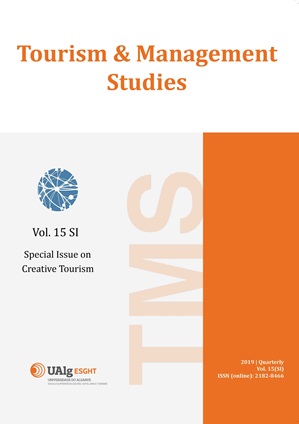Creative tourism: opportunities for smaller places?
DOI:
https://doi.org/10.18089/tms.2019.15SI01Keywords:
Creative tourism, creativity, creative industries, small cities, rural areasAbstract
This paper aims to review the development of creativity in tourism, and analyses the potential role of smaller places in creative development. In the past, the role of creativity has been primarily analysed in larger cities. In recent years, more attention has been paid to the creative development of smaller cities and regions. We argue that smaller places should not attempt to emulate big city models of creative development, such as attracting the creative class, but should find their own creative mode based on using their endogenous resources, capacity building and bottom-up creativity. In this way they can avoid the ‘creativity trap’ of following generic creativity models and develop modes of creative tourism more appropriate to their size and capabilities.
References
References
Alonso, W. (1973) Urban zero population growth, Daedalus, 109:191-206.
Bell, D. and Jayne, M. (2006) Small Cities: Urban experience beyond the metropolis. London: Routledge.
Blapp, M. (2015). Creative Tourism in Bali’s Rural Communities Examination of the current offer and advice on future product development. MA Dissertation NHTV University of Applied Sciences in Breda, Netherlands, December 2015
Brouder, P. (2012) Creative outposts: Tourism's place in rural innovation. Tourism Planning & Development, 9(4), 383-396.
Bucci, A., Sacco, P.-L. and Segre, G. (2014) Smart endogenous growth: cultural capital and the creative use of skills. International Journal of Manpower, Vol. 35 No. 1/2, 2014, pp. 33-55.
CREATOUR (2017) The State of the Art in Creative Tourism. Call for Projects, CREATOUR.
Cunha Lima, F. B., and Flores e Silva, Y. (2017) " Project Querença" and creative tourism: visibility and local development of a village in the rural Algarve. E-review of Tourism Research, 14.
Duif, L. (2016) De magie van Bosch: Oude schilders, nieuwe citymarketing. MMNieuws, September.
Lewis, N. M., & Donald, B. (2009). A New Rubric for 'Creative City' Potential in Canada’s Smaller Cities. Urban studies, 47 (1), 29-54.
Machado, R., Fernandes, C. and Queiroz, J.P. (2014) Exploring the Biennial concept to promote new relationships in art, culture and alternative tourism. In Richards, G. and Russo, P. (eds) Alternative and Creative Tourism, Arnhem: ATLAS, pp. 70-81.
Meijers , Evert J. and Burger, Martijn J. (2015) Stretching the concept of ‘borrowed size’. Urban Studies.
OECD (2014) Tourism and the Creative Economy. Paris: OECD.
Pierce, J., Martin, D. G., and Murphy, J. T. (2011) Relational place?making: the networked politics of place. Transactions of the Institute of British Geographers, 36(1), 54-70.
Richards, G. (2014) Guimarães and Maribor, European Capitals of Culture 2012. Arnhem: ATLAS.
Richards, G. (2016) The challenge of creative tourism. Ethnologies, 38, 1-2, 31-45.
Richards, G. (2017) Heritage tourism: benefit or liability for cities? Are cities with a long history now suffering a quick death at the hands of tourism? Cartaditalia: Rivista di cultura italiana contemporanea, 2018, 395-415.
Richards, G. and Raymond, C. (2000). Creative Tourism. Atlas News, 1(23), 16-20.
Sacco, P.L. and Blessi, G. (2007) European Culture Capitals and Local Development Strategies: Comparing the Genoa 2004 and Lille, Homo Oeconomicus 24(1): 111–141.
Wisansing, J. (2015) Redesign tourism. Bangkok: DASTA.
Downloads
Published
Issue
Section
License
Copyright (c) 2019 Tourism & Management Studies

This work is licensed under a Creative Commons Attribution-NoDerivatives 4.0 International License.
The journal retains published articles’ copyrights, but they are simultaneously licensed under the Creative Commons Attribution License (CC BY-NC-ND), which allows individuals’ to share the relevant papers as long as authorship and publication in this journal are duly acknowledged.



